Juventus welcomed Lokomotiv Moscow to the Allianz Stadium in a battle between Group D teams in the UEFA Champions League. Juventus went into the match in joint first place with Atlético Madrid, while Lokomotiv Moscow sat third in the group, above Bayer Leverkusen.
Mauricio Sarri was able to guide his Italian based team to victory over Yuri Semin’s Russian side, 2-1. However, the match was by no means straightforward for the Italian Champions.
Juventus were favourites going into the match and predictably dominated possession and the majority of the chances throughout the game, although this match did not involve many ‘big chances’. Against the general run of play, Lokomotiv were able to take the lead in the 30th minute and were hopeful of holding onto the lead to win the game. However, as Juventus upped the tempo and offered some tactical adaptation via substitutions, the hosts were able to equalise in the 77th minute before going onto win the game in the 79th after a quick-fire double from Paulo Dybala.
This tactical analysis will investigate the match further and highlight how Juventus came away with the points against the highly competitive Lokomotiv Moscow. The analysis will include match line-ups, statistics, information on the offensive, defensive and transitional tactics from each team and their respective set-pieces.
Line-Ups
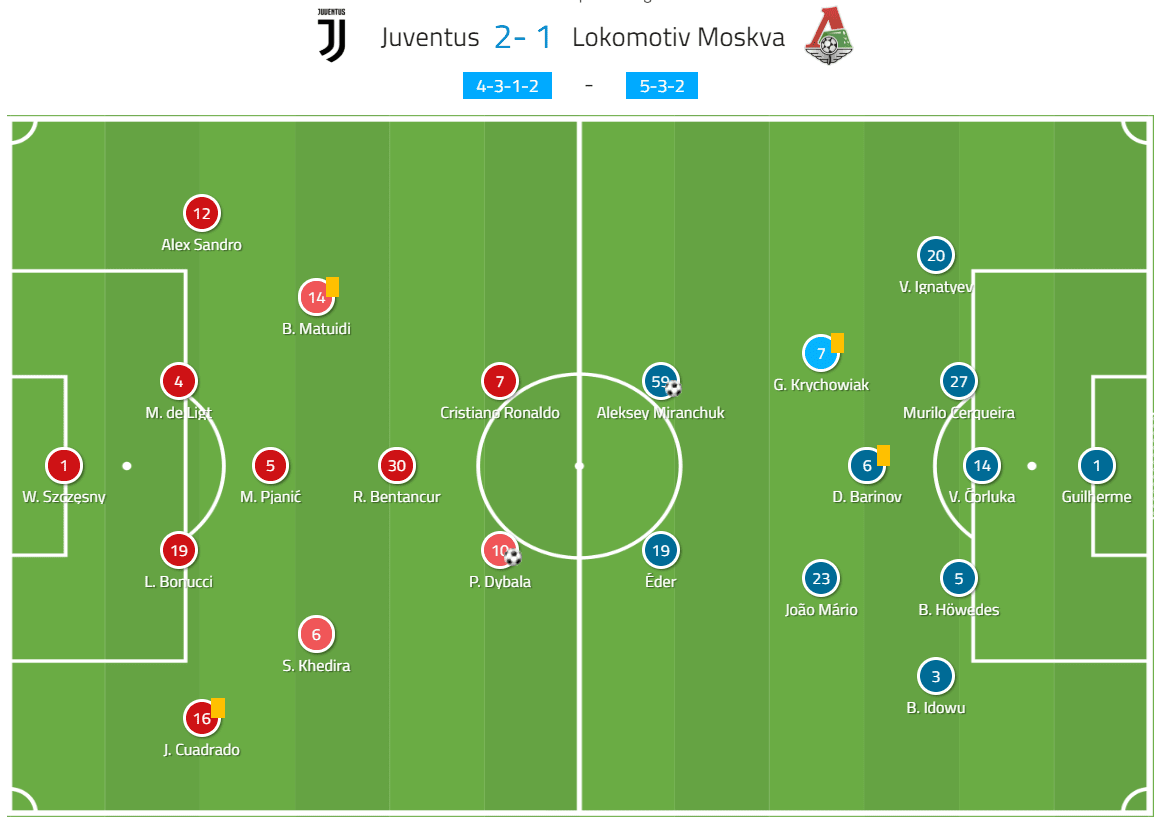
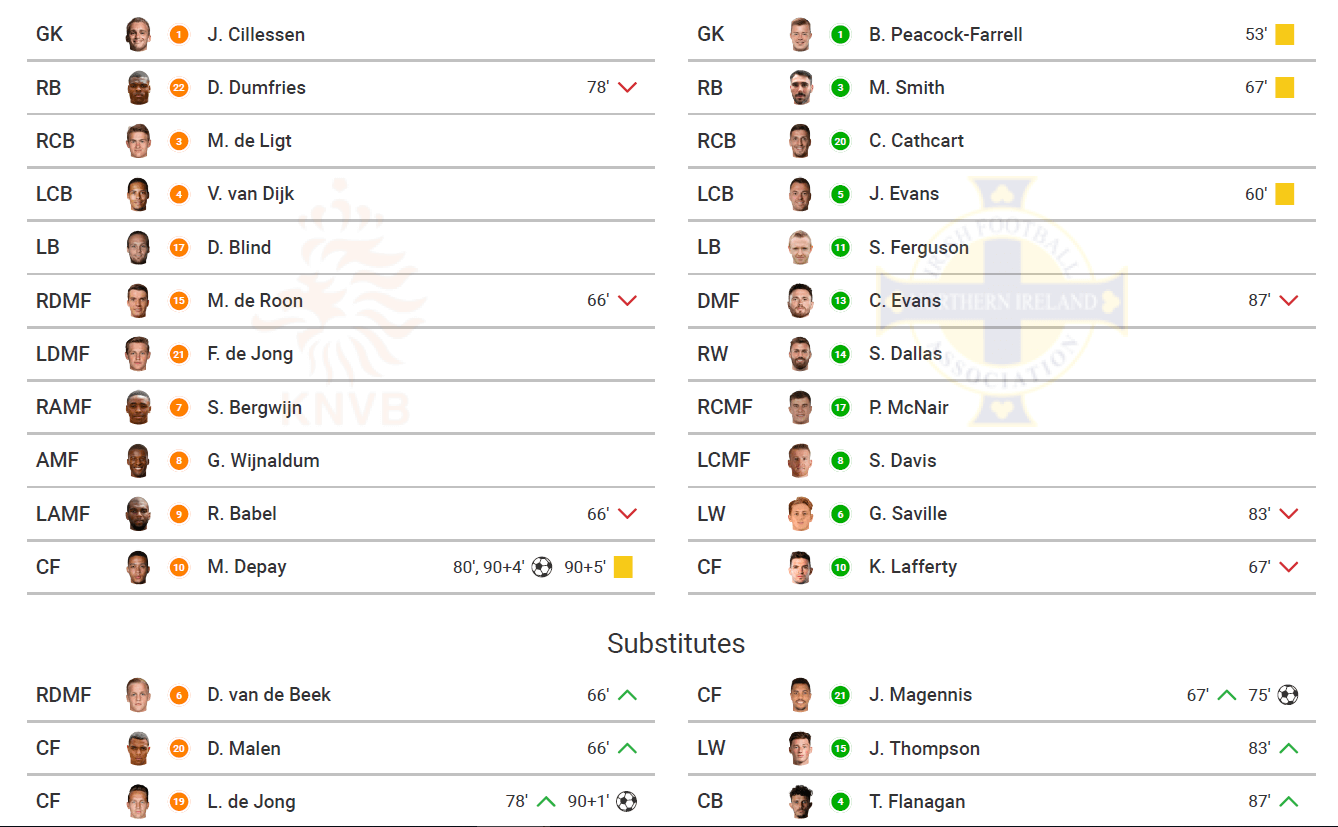
In terms of line-ups, there were no major surprises as the majority of key players who were fit for the match started. Juventus had high profile options to join play off the bench including Gonzalo Higuaín, Adrien Rabiot and Federico Bernadeschi, while Juan Cuadrado, who is a natural winger, continued to play at right-back as he had in the domestic league. Cuadrado has a large impact on the game, this will be discussed in the article.
Interestingly, Lokomotiv Moscow only made one substitution, perhaps not containing the high calibre of player that Juventus had on the bench in order to impact the match in an offensive or defensive manner. Such lack of options was likely to contribute to fatigue-related performance decreases for defensive players up against fresh attackers and midfielders.
Juventus operated using a 4-3-1-2 formation, alternatively, this may be termed a 4-4-2 diamond. Juventus have multiple high-quality central midfielders. Because of this, a formation which packs the central areas benefits them and their dominant ‘Sarri-Ball’ style of play, while the full-backs offer the natural width, given their advanced positions in matches where Juventus dictate possession.
Lokomotiv Moscow utilised a stereotypically defensive 5-3-2 formation, seemingly to nullify the offensive threat of favourites, Juventus, anticipating that they would need to retain shape and numbers behind the ball for large sections of the match.
The underlying tactical plan of the 5-3-2 when in possession was to counter-attack. If Lokomotiv Moscow won the ball, they could before break and attack with their offensive players, whilst still maintaining defensive solidity with the majority of players staying behind the ball.
Average positions and formation changes
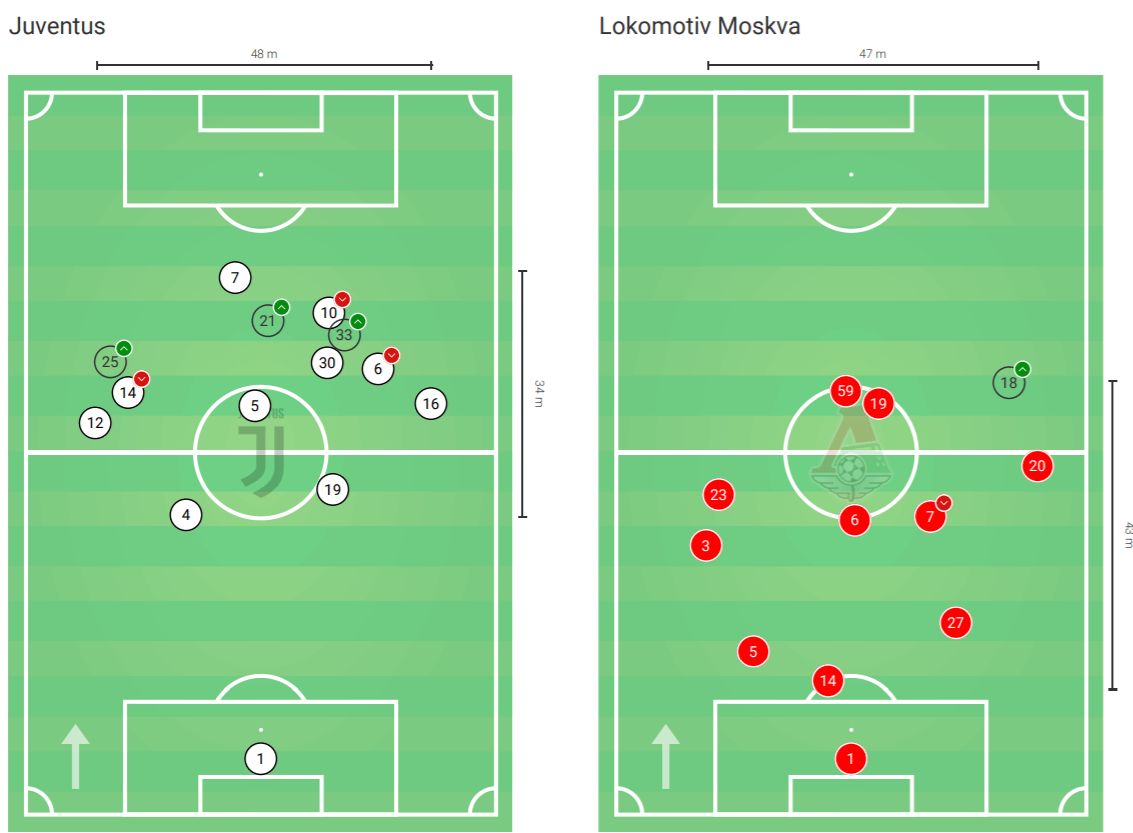
In regards to how the discussed formations translated into average positions, we can see that Juventus’ average formation became a 2-6-2 in practice. The advanced full-backs operated as wingers and the number ‘10’, on paper, dropped in to rotate with other central midfield players.
Lokomotiv Moscow’s formation also looks different when average positions are applied as the team essentially play a 3-5-2, however, all players are recognisably deeper than the opposition.
Interestingly, there appears to be a vacated space in front of the three centre backs for Lokomotiv. For the most part, Lokomotiv pushed Juventus out wide, given their five-man defence and three-man midfield forcing their opponents to the flanks. The average positions do not mean that there was never any player protecting that space, and it did not appear to be a consistent area of threat from Juventus, but, such space did lead to chances on occasion when gaps did occur. To develop that point, offensive space was offered in the goals in front of the midfield three and defensive five who both dropped back deeper and offered the space just outside the box for shots from distance, rather than space between the unit lines.
When attacking, Lokomotiv Moscow often committed two or three players to an attacking phase in order to try to create chances whilst also securing themselves should they lose the ball. This can be identified as number 59, Aleksey Miranchuck, and 19, Eder, both operated in close proximity. Given Juventus’ dominance, Lokomotiv frequently played a direct style in order to find forward, Eder, who linked closely with Miranchuck or midfielder João Mário who on occasion joined to add more attacking threat and defensive unrest for Juventus.
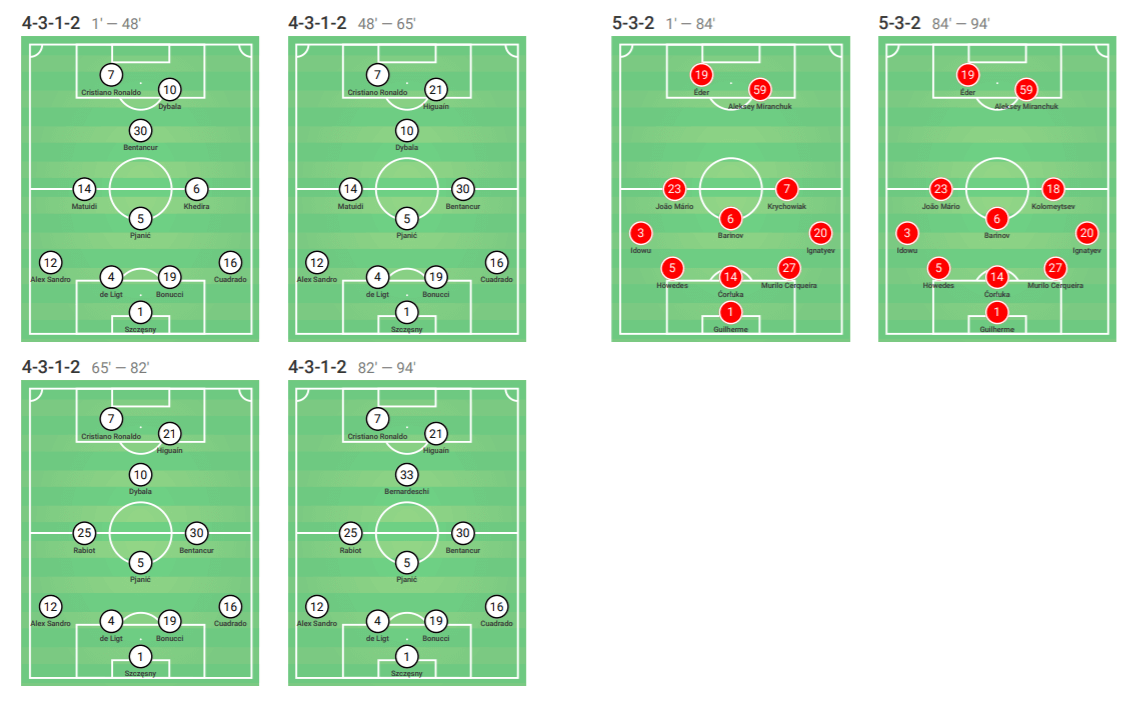
While the average positions present interaction and movement around the set formation, as seen via the formation changes image, neither team deviates majorly from their initial setups on paper.
Match Stats
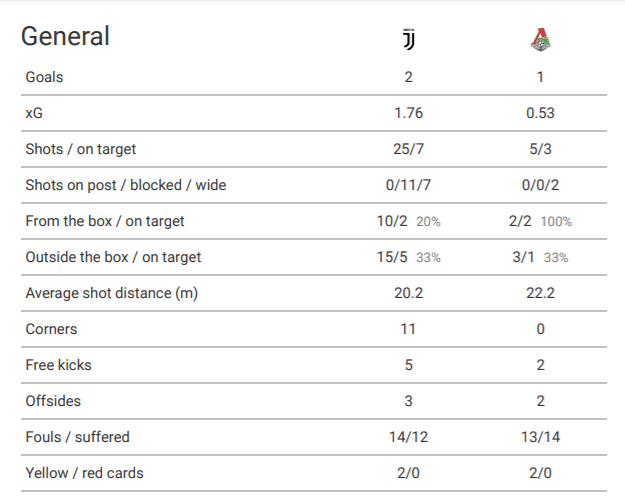
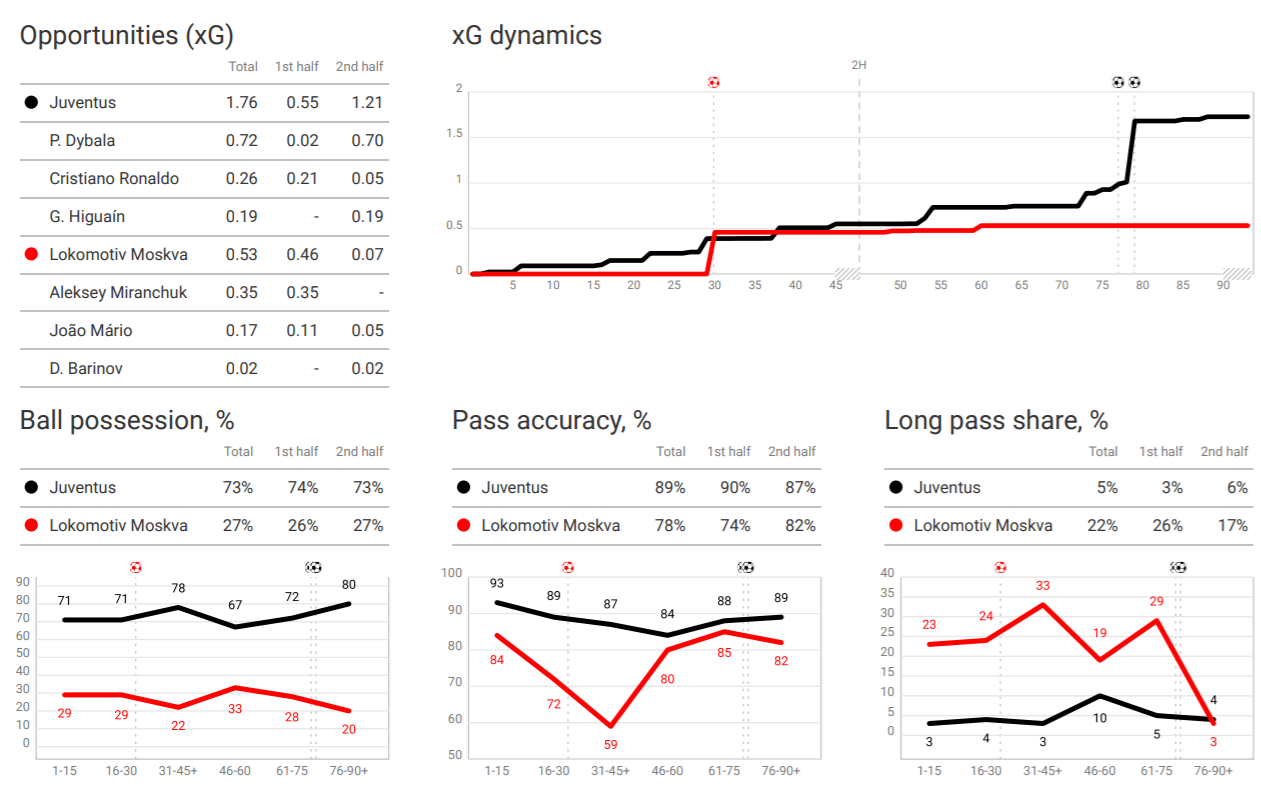
As highlighted, Juventus dominated possession with short passing, while Lokomotiv attempted a more direct game to hurt the high line of Juventus. This is portrayed in the stats as Juventus had more possession in each 15-minute section, a higher pass accuracy throughout and a lower long pass share.
In terms of xG, we can see that Juventus built slowly with numerous low percentage chances, while Lokomotiv’s successful attack to score the first goal in the 30th minute meant that on chance terms, the teams went in at half time very similar. Cristiano Ronaldo did miss a ‘big chance’, which would’ve raised Juventus’ xG, however, the Portuguese player was offside.
In the second half, Lokomotiv barely increased their xG, however, whilst winning 1-0, you would not expect large offensive commitments. Juventus created higher quality chances and took advantage of such chances in the second half as they wore the visitors down and benefitted from the addition of Higuaín which moved Dybala back slightly into a position where he could affect the play more. This, in turn, pushed Rodrigo Bentancur into a deeper, more natural role.
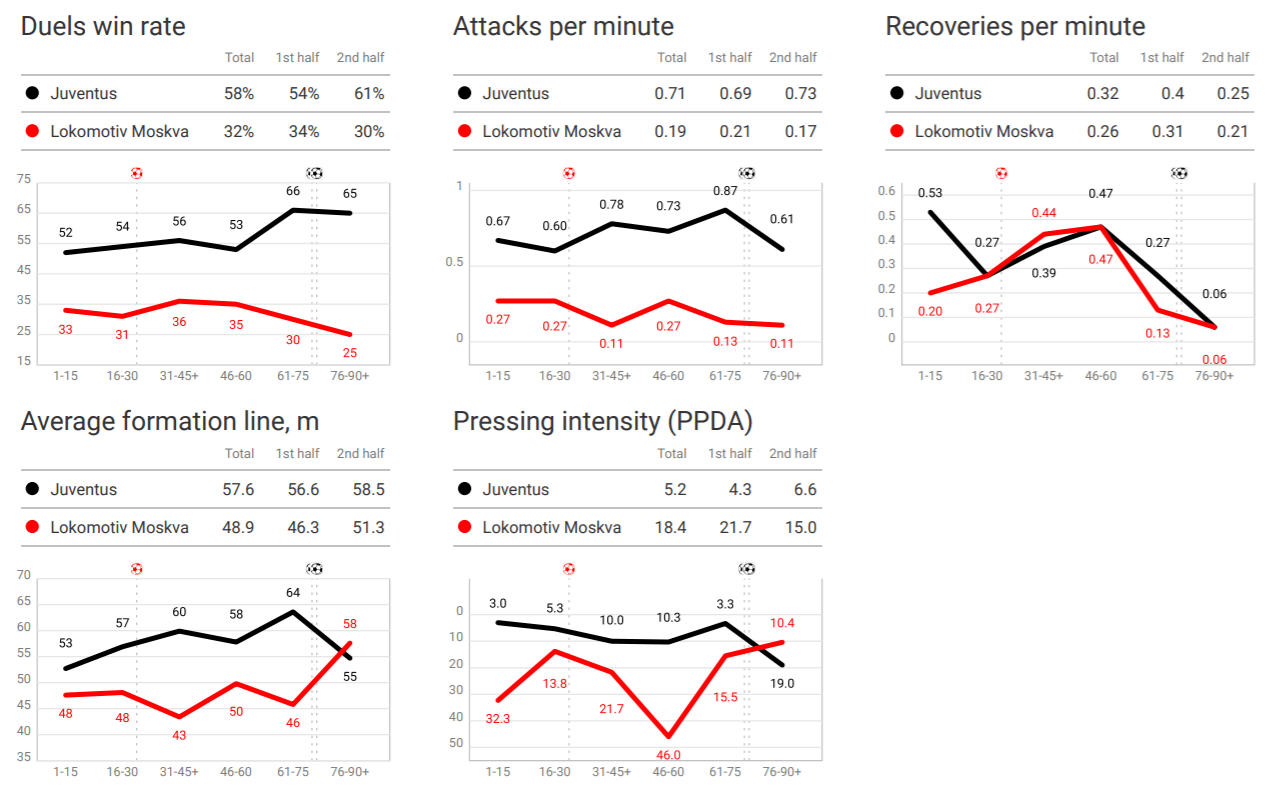
All of the above statistics confirm Juventus’ dominance in general phases of play and performance-based metrics, however, as stated, the outcome of a win was hard-pressed.
Juventus dominant in possession
Within possession, Juventus dominated but they were forced wide by the Lokomotiv block of three central midfielders, who restricted central space before moving out wide to help the back five, specifically the wing-backs, who generally played as full-backs. The phase of play moving out wide was natural for Juventus given the number of players they had in central areas and the advancing left and right full-backs, Alex Sandro and Cuadrado. Given Lokomotiv’s focus on all of Juventus’ central players, the full-backs players were consistently free options to achieve further progression, cross or get beyond the defensive line in a 1v1.
Cuadrado was very successful within these phases for Juventus. The Colombian made the most passes, 121, the most crosses, nine (9), and the second most dribbles, six (6) in the Juventus team, ahead of typically more advanced teammates. He was able to cross prior to taking on the opposing wingback or after beating him in a 1v1. The crosses from Cuadrado weren’t majorly successful due to effective defending from the five Lokomotiv defenders, however, Cuadrado was consistently available and effective in dribbling and getting the ball into dangerous areas. His ball created the ‘big chance’ for Ronaldo, who fluffed his lines before being somewhat saved by the offside flag. On the other side, Sandro also saw a lot of the ball, crossing the ball five (5) times, the second-most of Juventus players, the fourth most passes, 79, and fourth highest number of dribbles with three (3).
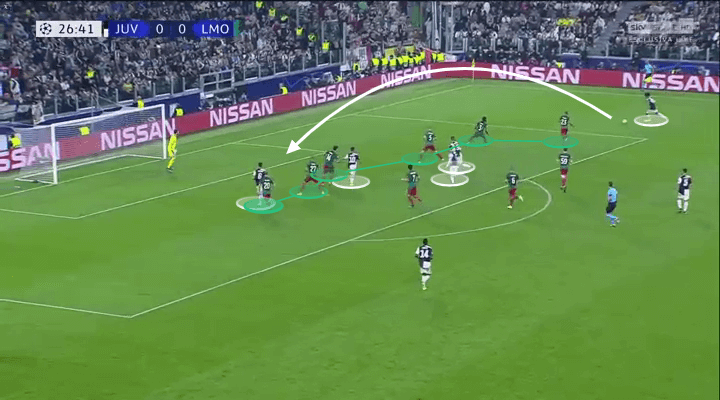
Juventus often played the ball in the offensive ‘U’ shape with the full-backs as the most advanced as the team moved the ball and looked for crossing opportunities and space between opposition lines to work in. Whilst the full-backs created chances from out wide, numerous players dropped off to take shots from outside the box.
However, when the full-backs decided received the ball and the opposition predicted a move out wide or cross, on occasion, the full-backs unpredictably moved or passed inside. Given the full-backs were the spare men in the offensive, defensive interaction, this opened up shooting opportunities or forced an opposing player to close them down, leaving another Juventus attacker free.
Such attacking phases happened for both goals, again highlighting the influence of the full-backs. For the first goal, Cuadrado stayed narrower than usual and played the ball to Dybala, who had the opportunity to drop off given the introduction of Higuaín up-front. Dybala gained half a yard and curled the ball past the opposition goalkeeper with power. This goal saw Dybala operate in the space in front of the Lokomotiv midfield and defensive line who dropped off due to the expectation of a cross and the advancing Juventus numbers.
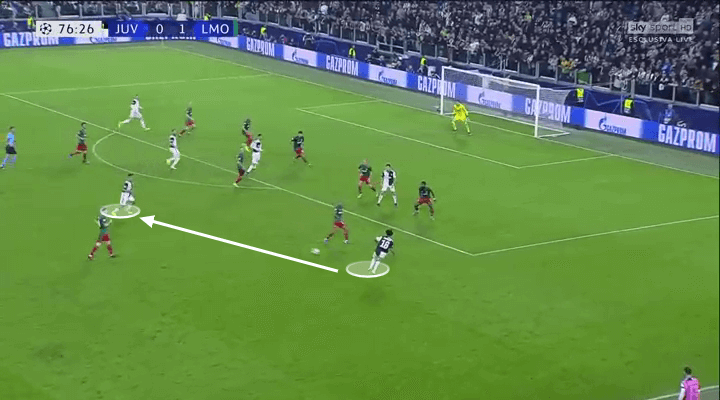
For the second goal, it was Sandro who took a shot from distance and whilst the shot did not go in, it forced a good save from the goalkeeper who could only parry it before Dybala was the first to react to tap home. There were few other occasions, due to the deep block and number of defensive players, where Juventus were able to get a player between the defensive line and the goalkeeper, it took a longshot from a free player to trigger such opportunities.
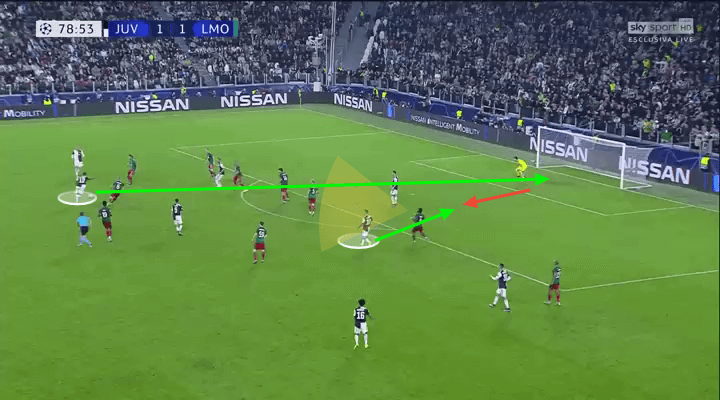
Lokomotiv utilise few players to press and attack
The phases of offensive transition and possession for Lokomotiv Moscow look very similar due to Moscow’s lack of overall possession. Within transition, the visitors looked to adopt a high tempo, a direct style which involved direct passing to the two forwards, Eder and Miranchuck, or, direct dribbling in terms of running at the high Juventus line. Lokomotiv did press, but a team press was not applied. For the most part, the Juventus defenders were allowed time on the ball to play it between themselves, with Lokomotiv only engaging when Juventus tried to advance in their defensive half. This is verified by the high PPDA statistic, 18.4.
The visitors pressed in ones and twos against Juventus’ defensive line when they had the ball, attempting to win the ball or disrupt their play whilst maintaining defensive solidity, rather than coming out in larger groups to press the ball where they would likely be passed through due to the quality of the Juventus players. On multiple occasions, the Lokomotiv players were able to intercept passes or nick the ball from Juventus defenders or midfielders who had dropped deep. When doing so, they broke away with one or two players in support and tried to hurt the Juventus defensive. A numerical inferiority was common, but, if Lokomotiv moved the ball well between the breaking players, they did make progress towards the Juventus goal, buying their defenders time even if unable to threaten the Juventus goal fully.
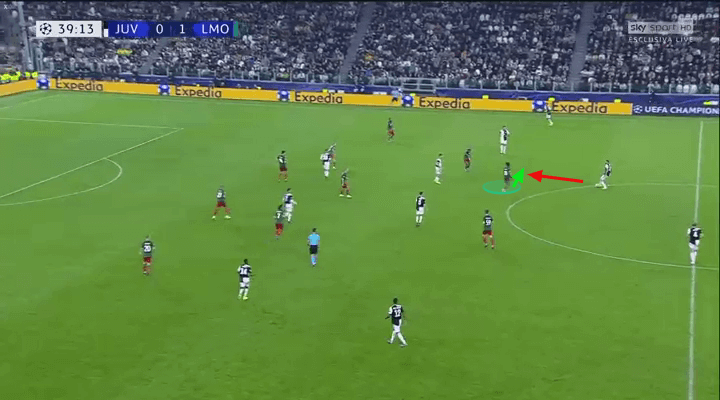
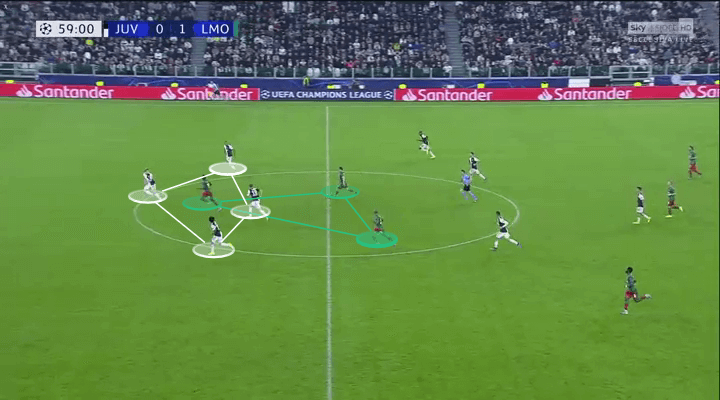
Lokomotiv’s direct style
When the ball was won deeper, or possession was gained via the goalkeeper, more direct passing occurred. The goalkeeper, Guilherme, can produce an extremely long kick. In a similar fashion to the offensive transition, two or three players attempted to capitalise on the long ball, Eder, Miranchuck and Mário. Eder was effective in disrupting the centre-back who attempted to win the header. The forward was not always successful in winning the aerial duel himself, but his impact affected the quality of the header from the Juventus defenders and was reacted upon by Miranchuck and Mário who were alive to second balls. It was in this situation where Lokomotiv Moscow were able to score the opening goal. A long kick from the keeper, Eder causing disruption, Miranchuck getting on the ball, Mário supporting in a two vs three situations in favour of Juventus, Miranchuck found the Portuguese whose initial strike was saved before Miranchuck volleyed in the rebound.
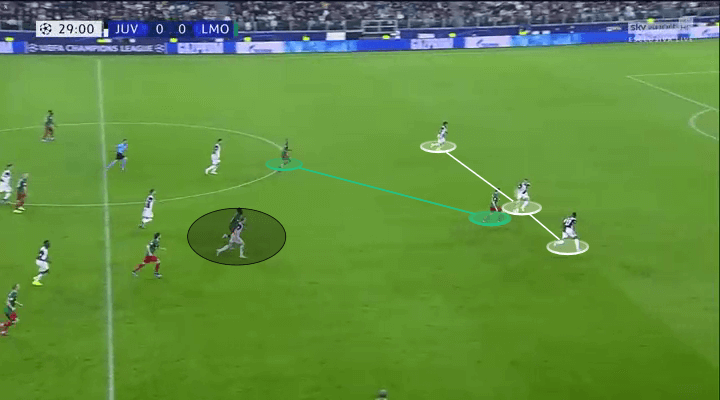
Juventus struggle to gain numerical superiority in transition
For Juventus, the moments of offensive transition were limited due to their ball dominance and short cycles of possession for Lokomotiv Moscow. Given their average formation high up the pitch and the depth of Lokomotiv, Juventus played with an intense press in terms of PPDA (5.2). When Juventus were able to win the ball back, they looked to attack quickly in order to capitalise on any Lokomotiv players who were the wrong side of the ball or out of position within their block. Given Lokomotiv’s depth and Juventus’ high positioning, this did not happen on many occasions as the Lokomotiv players rarely built possession high up the pitch or committed too many men forward for Juventus to exploit. Therefore, Juventus had to try and find solutions to the offensive headache that Lokomotiv caused them within longer possession sequences.
Ineffective set-pieces
As possession was dominated by Juventus in the Lokomotiv half and down the flanks on numerous occasions, the set pieces generally fell Juventus’ way in terms of direct free kicks, indirect free kicks and corners. Despite this, Juventus only created one chance of note, a free-kick crossed in from deep on the right flank which was glanced wide by Leonardo Bonucci. This was in part due to Juventus’ ineffective deliveries, with some not beating the first man, the aggressive nature of Lokomotiv defenders to win the ball in aerial challenges and the mixed zonal and man-marking system adopted at free-kicks and corners. Juventus, despite their talented players from dead balls, did not threaten from free-kicks within shooting range either.
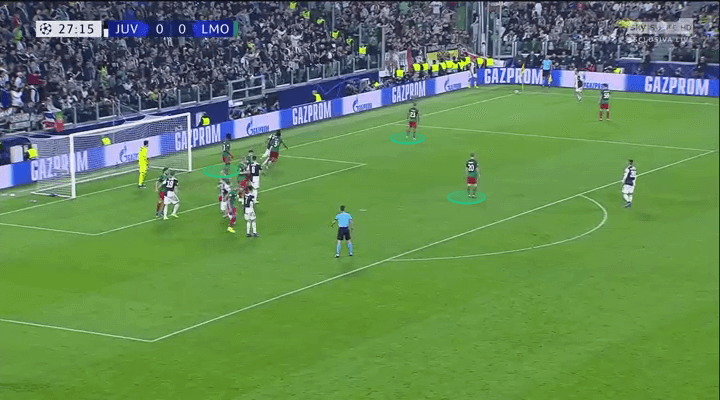
Conclusion
Overall, Juventus and Sarri were able to win the match against the Lokomotiv Moscow side under the reign of Yuri Semin. Lokomotiv were effective in nullifying Juventus’ ball dominating offensive players and struck effectively using a direct style of play. While the visitors defended superbly for most of the match and stood strong against Juventus’ attempts to break them down, the hosts were able to win the game via effective attempts from distance. Lokomotiv can be proud of their efforts given they were 15 minutes away from victory in Turin, but, without winning comfortably, the Italian champions found a way to win.

If you love tactical analysis, then you’ll love the digital magazines from totalfootballanalysis.com – a guaranteed 100+ pages of pure tactical analysis covering topics from the Premier League, Serie A, La Liga, Bundesliga and many, many more. Buy your copy of the October issue for just ₤4.99 here




Comments